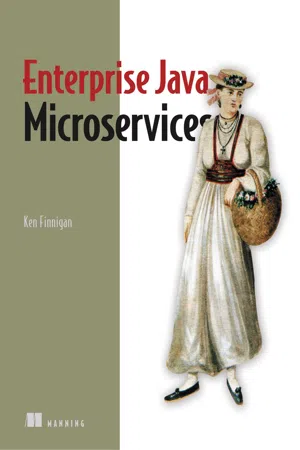
- 272 pages
- English
- ePUB (mobile friendly)
- Available on iOS & Android
Enterprise Java Microservices
About this book
Summary Enterprise Java Microservices is an example-rich tutorial that shows how to design and manage large-scale Java applications as a collection of microservices.Purchase of the print book includes a free eBook in PDF, Kindle, and ePub formats from Manning Publications. About the Technology Large applications are easier to develop and maintain when you build them from small, simple components. Java developers now enjoy a wide range of tools that support microservices application development, including right-sized app servers, open source frameworks, and well-defined patterns. Best of all, you can build microservices applications using your existing Java skills. About the Book Enterprise Java Microservices teaches you to design and build JVM-based microservices applications. You'll start by learning how microservices designs compare to traditional Java EE applications. Always practical, author Ken Finnigan introduces big-picture concepts along with the tools and techniques you'll need to implement them. You'll discover ecosystem components like Netflix Hystrix for fault tolerance and master the Just enough Application Server (JeAS) approach. To ensure smooth operations, you'll also examine monitoring, security, testing, and deploying to the cloud. What's inside
- The microservices mental model
- Cloud-native development
- Strategies for fault tolerance and monitoring
- Securing your finished applications
About the Reader This book is for Java developers familiar with Java EE. About the Author Ken Finnigan leads the Thorntail project at Red Hat, which seeks to make developing microservices for the cloud with Java and Java EE as easy as possible. Table of Contents
PART 1 MICROSERVICES BASICS
- Enterprise Java microservices
- Developing a simple RESTful microservice
- Just enough Application Server for microservices
- Microservices testing
- Cloud native development
PART 2 - IMPLEMENTING ENTERPRISE JAVA MICROSERVICES
- Consuming microservices
- Discovering microservices for consumption
- Strategies for fault tolerance and monitoring
- Securing a microservice
- Architecting a microservice hybrid
- Data streaming with Apache Kafka
Frequently asked questions
- Essential is ideal for learners and professionals who enjoy exploring a wide range of subjects. Access the Essential Library with 800,000+ trusted titles and best-sellers across business, personal growth, and the humanities. Includes unlimited reading time and Standard Read Aloud voice.
- Complete: Perfect for advanced learners and researchers needing full, unrestricted access. Unlock 1.4M+ books across hundreds of subjects, including academic and specialized titles. The Complete Plan also includes advanced features like Premium Read Aloud and Research Assistant.
Please note we cannot support devices running on iOS 13 and Android 7 or earlier. Learn more about using the app.
Information
Part 1. Microservices basics
Chapter 1. Enterprise Java microservices
- Enterprise Java history
- Microservices and distributed architecture
- Patterns for migration to microservices
- Enterprise Java microservices
1.1. Enterprise Java—a short history
1.1.1. What is Enterprise Java?
1.1.2. Typical Enterprise Java architecture
Definition
Figure 1.1. Typical Enterprise Java application architecture

Note
1.1.3. What is a monolith?
Table of contents
- Copyright
- Brief Table of Contents
- Table of Contents
- Preface
- Acknowledgments
- About this book
- About the author
- About the cover illustration
- Part 1. Microservices basics
- Part 2. Implementing Enterprise Java microservices
- Appendix. Spring Boot microservices
- Index
- List of Figures
- List of Tables
- List of Listings